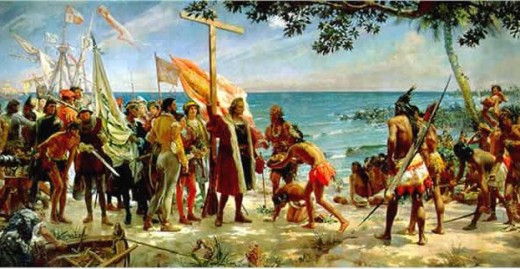Contact between Europeans and Native American peoples manifested in very different ways depending on the specific groups and regions in which contact was made. In some regions, the European settlers had more cooperative relationships with the Natives, and in other places the primary focus was on converting and conquering the indigenous tribes. Ultimately, these interactions shared the trait that they were all done with self interest in mind.
As Thomas Benjamin mentions in the text, The Atlantic World: Europeans, Africans, Indians and Their Shared History, 1400-1900, “More than anything else, Christian evangelization was the justification for empire and colonization in the Americas.” This means that missionary practices and the pursuit of spreading Christianity to the natives was one of the greatest motivations for the colonists on the American continents.
Due to this motivation and practice, one of the most significant cross-cultural relationships that was established involved religious conversion, native resistance or acceptance of this, the way that the missionaries interacted with and came to understand the native people, and what this meant for the cultural identities of the indigenous people. One of the greatest factors which conditioned these types of relationships was the European perception of the indigenous Americans as being savages, barbarians, and heathens.
Europeans had come into contact with countless cultures which were very different from their own by the time that they came to the Americas, so they should have been accustomed to and able to recognize extreme cultural differences. However, because of the differences in dress, appearance, and means of worship were so significant between them and the indigenous Americans, they adopted a belief that the native people were wild, untamable, and uncivilized people who were hardly even than human.
Europeans initially believed the Native Americans to be entirely without religion, but upon extended interaction and communication, some missionaries realized that the native people did in fact hold spiritual beliefs. To some missionaries, this meant that they were heathens and had denied the word of God rather than being innocent and unaware of God.
Some argued that this meant that they deserved to be enslaved and conquered, others such as Bartolome de las Casas (a Spanish colonial historian of the era) argued that they didn’t deserve blatant cruelty, but only conversion. These beliefs about the savagery and wildness of the Native people was a major factor in how the Europeans approached them and in what ways they chose to pursue relationships with the tribes.
In the context of missionary endeavors to convert Native Americans to the regionally accepted forms of Christianity, cultural identity among the natives expressed itself in different ways. For some missionaries, like Fray Ramon, of Hispaniola, who was selected by Columbus to live among natives and report his findings in 1495, as he lived with the native people, he learned a great deal about the native cultures. Coexisting with the Taino people, Fray Ramon learned their creation myths, their customs, and their way of life.
The cultural identity of the Taino people allowed those Europeans who would listen to realize that they were more than just uncivilized wild people. After what could be considered successful mass conversion, many native people would participate in Catholic worship while among the colonists and by all appearances have completely accepted their new religion. However, it was found that the natives would often go off into hidden areas together to worship their old idols and spirituality in secret.
In this way, the indigenous peoples were working and risking punishment in order to maintain their cultural identity so that it could survive through to further generations. This is an example of how conquered groups of people would behave how their conquerors expected them to but would secretly hold onto their culture and beliefs so that it may go on and escape complete destruction by the hands of those who have otherwise decimated their population.

The significance of the interactions between Europeans and Native American peoples cannot be understated. The entire future of the Western hemisphere was forever changed from the very start of European colonization in the Americas.
The spread of diseases for which the native people had no biological resistance wiped out a huge percentage of the indigenous population. The Columbian exchange of disease, wildlife and livestock, and crops would forever change the environment of the Americas as well as that of European countries which received harvests from the Americas. The spread of Christianity into the new world, the forever lost histories of the native people who were at one point, rich in culture and belief, and the growth of European colonies had immeasurably huge impacts on the way that entire world would continue to evolve.
An interesting point is the record of Adraen van der Donck, a Dutch missionary who migrated to New Netherland, and lived along the Hudson River for five years surrounded by Native American people. He learned an Iroquian language and observed the tribal people around in him great detail. He wrote about how they were actually very civilized, if not in the same way as the Europeans. They had full and functional governmental systems which were hugely democratic. He wrote that at first sight, these people seemed extremely strange.
But if one would actually associate with them, and get to know them, those things that make them seem so foreign and different fade away and familiarity and understanding begins to take over. While their customs and dress were so very different from those of the Europeans, their behaviors and daily lives were not so strange. Those who lived among the native people and kept an open and reasonable mind eventually stopped believing that they were nothing but animals and savages living in the wild.
Source: Owlcation.com







